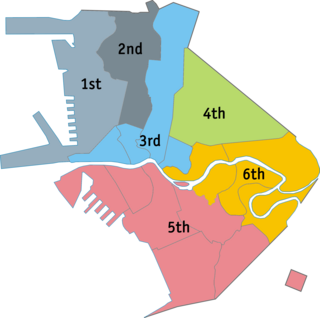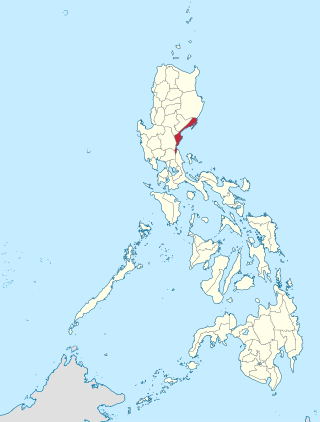The legislative districts of Abra are the representations of the province of Abra in the various national legislatures of the Philippines. The province is currently represented in the lower house of the Congress of the Philippines through its lone congressional district.

The highly urbanized city of Manila is currently represented in the House of Representatives of the Philippines by its six congressional districts. Every three years, each district elects one representative who will sit on their behalf in Congress. In addition, each district is allotted six seats in the Manila City Council, with councilors being elected every three years.
The legislative districts of Agusan del Norte are the representations of the province of Agusan del Norte in the various national legislatures of the Philippines. The province is currently represented in the lower house of the Congress of the Philippines through its first and second congressional districts.

The legislative districts of Rizal are the representations of the province of Rizal in the various national and local legislatures of the Philippines. At present, the province is represented in the House of Representatives of the Philippines by its four congressional districts, with the districts' representatives being elected every three years. Additionally, each district is allotted a certain number of seats in the Rizal Provincial Board, with board members also being elected every three years.
The legislative district of San Juan–Mandaluyong was the combined representation of the Metropolitan Manila municipalities of Mandaluyong and San Juan in the Regular Batasang Pambansa (1984–1986) and the lower house of the Congress of the Philippines (1987–1995).

The legislative districts of Cebu are the representations of the province of Cebu in the various national legislatures of the Philippines. At present, the province is currently represented in the House of Representatives of the Philippines by its seven congressional districts, with their respective representatives being elected every three years. Locally, the districts are also allotted two seats in the Cebu Provincial Board, with board members also being elected every three years.
The legislative districts of Aklan are the representations of the province of Aklan in the various national legislatures of the Philippines. The province is currently represented in the lower house of the Congress of the Philippines through its first and second congressional districts.
The legislative districts of Agusan del Sur are the representations of the province of Agusan del Sur in the various national legislatures of the Philippines. The province is currently represented in the lower house of the Congress of the Philippines through its first and second congressional districts.
The legislative districts of Batangas are the representations of the province of Batangas in the various national and local legislatures of the Philippines. At present, the province is represented in the House of Representatives of the Philippines by its six congressional districts, with the districts' representatives being elected every three years. Additionally, each district is allotted two seats in the Batangas Provincial Board, creating a total of twelve elective seats in the legislature.
The legislative districts of Albay are the representations of the province of Albay in the various national legislatures of the Philippines. The province is currently represented in the lower house of the Congress of the Philippines through its first and second, and third congressional districts.
The Interim Batasang Pambansa was the legislature of the Republic of the Philippines from its inauguration on June 12, 1978, to June 5, 1984. It served as a transitional legislative body mandated by the 1973 Constitution as the Philippines shifted from a presidential to a semi-presidential form of government.
The legislative districts of Baguio are the representations of the highly urbanized city of Baguio in the various national legislatures of the Philippines. The city is currently represented in the lower house of the Congress of the Philippines through its lone congressional district.
The Legislative district of Las Piñas–Parañaque was the combined representation of the Metropolitan Manila municipalities of Las Piñas and Parañaque in the Regular Batasang Pambansa from 1984 to 1986.
The legislative districts of Cebu City are the representations of the highly urbanized city of Cebu in the various national legislatures of the Philippines. The city is currently represented in the lower house of the Congress of the Philippines through its first and second congressional districts.
The legislative districts of Davao City are the representations of the highly urbanized city of Davao in the various national legislatures of the Philippines. The city is currently represented in the lower house of the Congress of the Philippines through its first, second, and third congressional districts.
The legislative districts of Cotabato are the representations of the province of Cotabato in the various national legislatures of the Philippines. The province is currently represented in the lower house of the Congress of the Philippines through its first, second, and third congressional districts.
The legislative districts of Marinduque are the representations of the province of Marinduque in the various national legislatures of the Philippines. The province is currently represented in the lower house of the Congress of the Philippines through its lone congressional district.
The legislative districts of Palawan are the representations of the province of Palawan and the highly urbanized city of Puerto Princesa in the various national legislatures of the Philippines. The province and the city are currently represented in the lower house of the Congress of the Philippines through their first, second, and third congressional districts.

The legislative districts of Quezon are the representations of the province of Quezon and the highly urbanized city of Lucena in the various national legislatures of the Philippines. The province and the city are currently represented in the lower house of the Congress of the Philippines through their first, second, third, and fourth congressional districts.

Aurora's at-large congressional district is the sole congressional district of the Philippines in the province of Aurora. It has been represented in the House of Representatives since 1987 and earlier in the Batasang Pambansa from 1984 to 1986. Aurora first elected a single representative provincewide at-large for the Regular Batasang Pambansa following its creation as a regular province separate from Quezon in 1978 and the subsequent 1984 Philippine constitutional plebiscite that amended the 1973 constitution and abolished the regional at-large assembly districts. Before 1978, the province was represented in the national legislatures as part of Quezon's 1st congressional district. The district was re-created on February 2, 1987 following the ratification of the 1987 constitution that restored the House of Representatives. It is currently represented in the 18th Congress by Rommel T. Angara of the Laban ng Demokratikong Pilipino (LDP).






